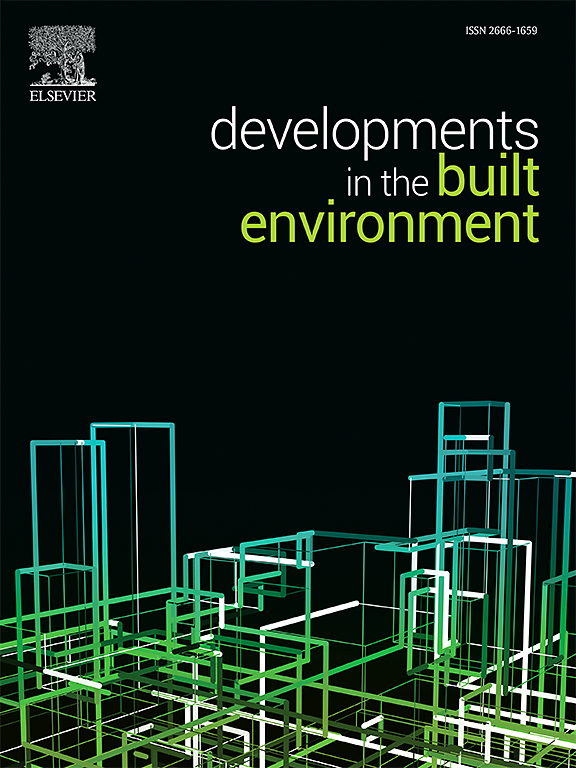Predicting long-term tensile degradation of GFRP rebars embedded in concrete with a reconsidered environmental reduction factor CE
IF 6.2
2区 工程技术
Q1 CONSTRUCTION & BUILDING TECHNOLOGY
引用次数: 0
Abstract
Glass fiber reinforced polymer (GFRP) has been considered as an advanced material to replace conventional steel reinforcements in concrete structures to address the corrosion issue. The degradation of GFRP rebars, which may threaten both the durability and safety of infrastructures, is a major concern. To predict the 100-year strength retention of GFRP under various temperature and relative humidity conditions, the environmental reduction factor () is applied in engineering. The conventional based on the assumption of logarithmic degradation model is commonly utilized during the degradation phase spanning from a few years to decades; however, it is not applicable to the initial and perpetual degradation phases. To address this issue, a novel environmental reduction factor () based on the exponential degradation model considering temperature and relative humidity is proposed in this study. Both and are mathematically deduced from empirical degradation data and then evaluated in a case study involving GFRP-concrete samples soaked in water at 23, 40 or 60 °C for up to 12 months within the authors’ dataset. Experimental results show that the GFRP tensile strength degradation is closer to the exponential model, reaching a plateau (47.4%) after 12-month exposure to 60 °C water. Moreover, the tensile strength retention of GFRP rebars in Vancouver (10 °C), Shanghai (16 °C) and Houston (22 °C) is predicted considering various scenarios of relative humidities (0–90%). Further research indicates that (0.65–0.78) exhibits a smaller value compared to (0.81) at a temperature of 22 °C and a relative humidity of 90% following a 100-year exposure period, thereby providing engineers with a more conservative design approach for GFRP in real-world scenarios. Nevertheless, this exponential degradation model requires a thorough consideration of severe degradation state during the extended aging period, which may not be applicable to GFRP structures exhibiting exceptional durability.
用重新考虑的环境减少因子CE预测混凝土中嵌入的玻璃钢钢筋的长期拉伸退化
玻璃纤维增强聚合物(GFRP)已被认为是一种先进的材料,以取代传统的钢筋混凝土结构,以解决腐蚀问题。玻璃钢钢筋的劣化对基础设施的耐久性和安全性构成威胁,是一个值得关注的问题。为了预测GFRP在不同温度和相对湿度条件下的百年强度保持,将环境折减系数(CE)应用于工程中。在几年到几十年的退化阶段,通常采用基于对数退化模型假设的传统CE;然而,它不适用于初始和永久退化阶段。为了解决这一问题,本文提出了一种基于考虑温度和相对湿度的指数退化模型的环境缩减因子。CE和CE都是从经验降解数据中数学推导出来的,然后在一个案例研究中进行评估,该案例研究涉及gfrp -混凝土样品在作者的数据集中浸泡在23、40或60°C的水中长达12个月。试验结果表明,GFRP抗拉强度衰减更接近指数模型,在60°C水中浸泡12个月后达到平台期(47.4%)。此外,考虑到不同的相对湿度(0-90%),预测了温哥华(10°C)、上海(16°C)和休斯顿(22°C) GFRP筋的抗拉强度保持。进一步的研究表明,在温度为22°C、相对湿度为90%的100年暴露期下,CE '(0.65-0.78)比CE(0.81)的值更小,从而为工程师提供了一个更保守的GFRP在现实场景中的设计方法。然而,这种指数退化模型需要充分考虑延长老化期间的严重退化状态,这可能不适用于具有特殊耐久性的玻璃钢结构。
本文章由计算机程序翻译,如有差异,请以英文原文为准。
求助全文
约1分钟内获得全文
求助全文
来源期刊

Developments in the Built Environment
Multiple-
CiteScore
7.40
自引率
1.20%
发文量
31
审稿时长
22 days
期刊介绍:
Developments in the Built Environment (DIBE) is a recently established peer-reviewed gold open access journal, ensuring that all accepted articles are permanently and freely accessible. Focused on civil engineering and the built environment, DIBE publishes original papers and short communications. Encompassing topics such as construction materials and building sustainability, the journal adopts a holistic approach with the aim of benefiting the community.
 求助内容:
求助内容: 应助结果提醒方式:
应助结果提醒方式:


